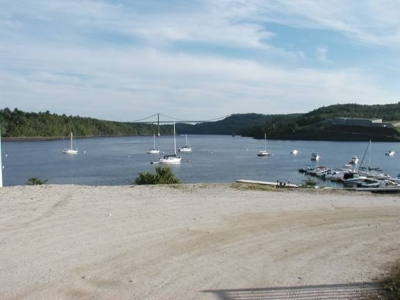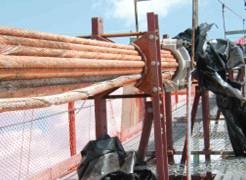Proposal for an Owner Facilitated Design-Build Process to Deliver the New Route 1 / Penobscot River Bridge
A Request to the Federal Highway Administration to utilize Innovative Contracting Procedures under Special Experimental Project 14 (SEP 14).

The Existing Waldo-Hancock Bridge U.S. Route 1 over the Penobscot River
MaineDOT
October 21, 2003
Executive Summary
Due to recently discovered main cable deterioration and 308 visible wire breaks on the Waldo-Hancock Bridge, the Maine Department of Transportation (MaineDOT) has taken immediate measures to ensure public safety including a 12 ton weight posting, vigorous twenty-four hour enforcement, continuous main cable monitoring for real time discovery of additional wire breaks, and the current installation of supplemental cables. In its present state, the existing bridge has failed to provide essential service on U.S. Route 1, an NHS arterial highway.
There is no guarantee that the bridge will remain serviceable at 12 tons until a new structure can be built. Although a Contractor is now installing supplemental cables to relieve some stress in the main cables, complete bridge closure will remain a possibility until a new crossing can be built. Even on an extreme fast track basis, MaineDOT estimates that it will take at least 3 years to construct a new parallel structure over the Penobscot River utilizing normal bidding practices or even conventional Design-Build.
In addition to public safety considerations, the loss of mobility on U.S. Route 1 is devastating the local economy. Local businesses are forced to use a 40 mile detour route to go a half mile from Prospect to Verona Island. Increased school bus costs are substantial. Tourism based shops and restaurants are reporting significant losses over previous years. The State's ability to respond quickly to a natural or other disaster at the Port of Searsport and points east is compromised. And the effect doesn't end at Bucksport - the Waldo-Hancock Bridge is the gateway to all of Downeast Maine.
With the assistance of the Federal Highway Administration (FHWA) Maine Division, MaineDOT has already selected the Figg Engineering Group (Figg) to begin preliminary design. We have prequalified three contracting teams using an open RFQ process, fast tracked the environmental documentation, secured our Governor's approval for this procurement process, and issued a draft Request for Proposals (RFP) for comment.
MaineDOT has established the following goals to provide a new bridge crossing:
- A high quality project,
- Open to traffic by June 30, 2005,
- A reasonable cost for the value received,
- A fair and competitive bidding process, and
- An early and productive relationship between the Designer and the Contractor.
MaineDOT hereby requests approval from the Federal Highway Administration under Special Experimental Project #14 (SEP 14) to utilize a unique contract delivery process which will meet the above stated goals. MaineDOT proposes to select a Contractor on a competitive Best Value basis with only a conceptual design completed, using Contractor qualifications and price (based on unit costs and representative quantities) for selection. The Department, its Designer, and the Contractor will then develop and sign a three party Design-Build Agreement for project delivery. This would allow the Contractor to interact early with the Designer much like a traditional Design-Build contract with quality, schedule, constructability, cost containment, and upfront VE benefits for the project. MaineDOT estimates that project delivery to the traveling public will be up to 1 year sooner under this approach.
1. Background
The Waldo-Hancock Bridge was completed in 1931, carrying U.S. Route 1 over the Penobscot River between Prospect and Verona Island. Approximately 10,000 vehicles per day use the bridge, with this number swelling to around 15,000 during the summer tourist season. The nearest alternate crossing is in Bangor, some 20 miles upstream.
The existing suspension bridge includes an 800 foot main span supported by 2 main cables, 9 inches in diameter, each comprised of 37 strands. These strands are made up of 37 helically spun wires. As recently as last February, Parsons Transportation estimated that the North cable safety factor was about 2.4, sufficient to continue the ongoing rehabilitation project. There was no reason to suspect that conditions on the South cable were any different.

As the remainder of the North cable and then the South cable were unwrapped, advanced corrosion and numerous broken wires were discovered. On the South cable, an entire main strand was broken, and it became evident that microcracking was also present with unknown extent. After the majority of main cable was unwrapped and strand specimens were tested for strength, the most damaged portions had only calculated safety factors of 1.7 (North cable) and 1.5 (South cable) at the posted limit of 12 Tons [see Appendix A].
With the main cables being fracture-critical tension members, load posting, aggressive enforcement, and extensive monitoring were immediately put in place [Appendix B]. Rehabilitation to carry vehicular traffic is no longer an option.
Of the 1369 individual wires in the South cable, between 25% and 30% are estimated to be broken or ineffective at carrying tensile force. Wire breaks have occurred even after the bridge was posted, and, according to the experts assembled to advise us, the cold Maine winters will make the wires even more brittle.
Supplemental cables are now being installed to remove load from the existing main cables to increase safety factors and extend their life. This plan is innovative, but it is uncertain how much load can be shifted to the temporary cables. Even with additional cables in place, complete bridge closure due to additional main cable wire breaks is possible.
2. The Impacts
MaineDOT's Bureau of Planning has estimated the economic impact of the current 12 ton posting, and the worse case scenario of complete closure of the bridge. These estimates are based on increased user costs alone, and cannot capture many hidden impacts such as lost tourism dollars and secondary business costs. The key findings of this preliminary analysis are as follows.
At the 12 ton posting,
- The total annual impact is between $12 and $17 million.
- A major local industry estimates their impact at $1 million per year.
- The Bucksport school system will incur substantial additional transportation costs to move students onto smaller school buses.
- Local businesses are already claiming that they could lose their company due to increased costs and reduced traffic.
- Trucks are traveling an average of 25 miles more to detour, with a 33 minute average increase in time.
- Cost per one way detoured trip from the Bucksport area range between $50 and $125.
- Tour buses have been reported to turn around at Belfast.
- Some RVs are over the posted limit and are being rerouted by the State Police.
In the event that complete closure becomes necessary,
- The total annual impact would be between $35 and $45 million.
- Traffic in-town Bucksport could be reduced by 33%.
- A round trip from / to Bucksport would increase by 80 miles and 96 minutes. Assuming 11 cents per mile and $11 per hour, closing the bridge would cost single occupant vehicles an additional $26.40 in user costs.
In additional to impacts on the local economy, it is reasonable to expect that MaineDOT will spend an unknown amount of funds to keep the existing bridge in service. The rehabilitation effort has already cost $7 million, and the supplemental cable system being installed now is estimated between $4 and $5 million. Additional work to keep this bridge in service for several years is an almost certainty. 24/7 weight enforcement is costing approximately $500,000 annually.
3. Project Delivery
MaineDOT's goal is to deliver a quality structure that will be open to traffic by July 1, 2005 [Appendix C]. Under either a design-bid-build or a design-build contracting method, the earliest possible open date is sometime in 2006. Although cost containment is always a priority, quality and speed are especially important to the State of Maine due to the enormous safety, mobility, and economic impacts of the current situation. A competitive bid approach would require a design and plans taking four to six months to complete, and a conventional Design-Build approach would also take too much up front time to recover on the other end.
A July 1, 2005 open date would preserve the majority of the 2005 tourist season and prevent the existing bridge from having to endure the harsh winter conditions for another year. The main cables will become even more brittle in the cold, snow will add dead load, and even plowing with light trucks will increase vibration and impact loading. To preserve public safety and meet the aforementioned project goals, the Governor of Maine used his statutory authority to allow the procurement process proposed in this request [Appendix D].
Although conventional Design-Build will not meet the schedule goal, MaineDOT believes that an early relationship between the Designer and Contractor is key to project success. Early identification of constructability issues and considering Contractor capabilities and Value Engineering opportunities in the design process are essential for quality, speed, and cost containment. To meet schedule, it will also be necessary to begin foundation work this Fall if we are to have any chance of opening the new bridge to traffic in 2005.
With FHWA's assistance, MaineDOT selected the Figg Engineering Group to provide design and construction support for the new bridge. Given the urgent nature of this project, MaineDOT has already prequalified three Contractors to compete for the construction work. We propose to select a Contractor based on qualifications and Reference Price, and then negotiate a Design-Build Agreement with Figg and the selected Contractor. This Agreement would be developed by the three Parties and include clear roles and responsibilities, scope, schedule, compensation, incentives for project success, and penalties for failure - all within the objective that risk and control must be clearly established and aligned.
The proposed procurement process is outlined as Appendix E, and the Draft RFP is attached as Appendix F. The three most unique contracting features in this process are: 1) A Design-Build Team with the Designer and Builder selected by the Owner, 2) the sequencing of design/construction "packages" similar to what Caltrans is doing with Design Sequencing, and 3) the use of a Reference Price to be able to consider cost during Contractor selection and as a basis for negotiation when design packages are completed. The Department believes that the combination of these techniques is the best way to ensure project success.
Specifically, this is a request for:
- Approval for this modified Design-Build process under SEP 14.
- Continued technical assistance from FHWA in project development, contracting, and construction of the project.
4. SEP 14 Final Report
MaineDOT believes that documenting the effectiveness of these proposed contracting techniques is essential to determine whether their usage may be beneficial to other projects. We propose to issue an SEP 14 Final Report similar to the one that we developed for the Sagadahoc Bridge Project, including background, process, conclusions, and lessons learned. This report is already on file with FHWA ("Final Report for SEP 14, Design-Build Contract for Sagadahoc Bridge . . .", dated 30 January 2002).
The SEP14 Final Report will document the significant differences between the selected contracting technique and the two other methods of project delivery contemplated for this project (design-bid-build and conventional design-build) in the following areas:
- risk transfer
- comparison of cost growth, quality, and schedule
- implementation of constructability and/or VE concepts
- issues with the use of Reference Prices and the negotiation of final Unit Prices
- adequacy of the $50,000 fee for design support services by the Contractor.

